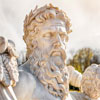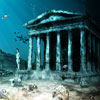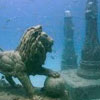Atlantean History – Part I
 By Yolen, Scribe of Atlantis
By Yolen, Scribe of Atlantis
Notes on Atlantean History during the Reign of Emperor Atlas:
In this abbreviated account of the eons of civilization of Atlantis, it must be remembered that such statements made, which refer to ancient times, may be verified by the records kept in the Museum of the Temple of Literature, of the City of Paradise. In this volume of current history, beginning with the coronation of Atlas, and continuing through to the present day—more than two decades since Atlas began his reign—the space is too limited to give more than the merest hint of events that were most important in ancient days. Hence we will say here that Ancient Atlantean Records prove conclusively that at the time of the First Deluge, 800,000 years ago, the Atlanteans led the entire world in civilization.
It is now generally known to Atlantean Templars that the awful cataclysms, known as the Second Deluge, 200,000 years ago, and the Third Deluge of 80,000 years ago, were caused by the chemicalizations of Nature in this physical world; they were the direct result of the vibrations of evil upon this earthly plane, conflicting with and resisting the relentless spiritual forces. Therefore it may be said that the frightful upheaval 80,000 years ago was brought about by the indifference and recklessness of mankind on earth, to the higher and inexorable Law of One—the spiritual Light that is the only Causation.
From the time of the Third Deluge of 80,000 years ago, down to the times of the Reign of Emperor Poseidon, Atlantis reached the highest peak of civilization—the highest this world shall ever reach. Since that time of wonders upon earth, the race has been retrogressing; civilization has not only been retarded, but is backsliding fast, as though to keep pace with the ever darkening state of mind of man. This retrogression was painfully noticeable throughout the latter days of Poseidon, and apparently gathered momentum in the reign of Dionysos, when the Pagans took firm root in Atlantis. Now after twenty years of the reign of Emperor Atlas, we have come to the place where the great Spiritual Teachers and Ancient Masters warn us of a Fourth Cataclysm—a final deluge, which will forever wipe out the Atlantean Empire, and her great and masterful race. UNLESS: heed these words of admonition from those Ancients of Days—Idolatry is abolished and the Sorcerers driven out of the land, and the People return to their first Principle—the communion in Light, with the Law of One. Only by the universal acceptance by the People of the Faith of the Templars, and the humble recognition once more of the Spirit, in each communicant with the Light, can the dire consequences of Idolatry be avoided, and Atlantis be made safe.
Just after that last paragraph, I have inserted an asterisk to draw attention to a note, in which I mention the maps following, which will give the reader a clear and comprehensive idea of the three stages of the Continent of Atlantis: the first at the time of the first recorded deluge, 800,000 years ago; the second map shows the continent as it was at the time of the Second Deluge, 200,000 years ago; and the third map shows the continent as it is at the present time, following the awful cataclysm of 80,000 years ago.*
*Reader please note this important addition made to the historical manuscript twenty years following the days when I compiled these pages: Since this preliminary reading on that fateful day, the Fourth Deluge took place, and completely submerged the Isle of Atlantis. Because of this cataclysm, which changed all the geography of the earth once more, the fourth map is shown here with the other three, in order to show simply to the reader where the Imperial Isle had been, and how the tremendous upheaval changed all things for the Atlanteans.
This is the logical place to insert maps, because the reader of history can compare the pictured continent and its empire, and see for himself just how the geography was changed by each deluge. The green tint which shows through the violet coloring on the maps shows where water has been, before the upheavals that raised land in different places, and changed geography completely at each cataclysm.
By studying these maps one can readily understand the widespread havoc wrought in the mighty Continent, until at last there was little of the original empire of Atlantis. But a peculiar fact must be noted: though the entire lands of the earth were completely changed in outline and conditions after each deluge, the coastline and western mountain ranges of Atla, better known as the Gold-Coast, remained much the same. Hence there are to be found there today as of yore the ancient towns and cities which were there at the time of the Third Deluge—80,000 years ago.
After this last cataclysm the empire recovered and took up life where it found it. But the Capital City, Paradise, was now isolated from the rest of the world. It remained on a vast Continent Isle surrounded by great waters, which were then named Atlantic. Notwithstanding such isolation, Paradise continued to be the seat of government for the world.
Is it not logical that such an important city, which nevertheless was cut off from her subsidiary nations, must have means by which the representatives and members of government of such lands could communicate and correspond with the supreme dictator city? Without the facility to keep in touch with the rest of the world, the Continent Isle would have to relinquish its imperial supremacy.
Consequently to maintain command of the commercial, industrial and financial exchanges throughout the world, Atlantis had to have great fleets of deep-seagoing vessels—of all sizes, forms and speed powers; and vessels for all purposes, as well. And we have them!
Vessels for traveling over the surface of the oceans and inland seas, ships for air navigation, for undersea journeys, require sailors, engineers, mechanicians and experienced navigators to take charge of and command them. Also these methods of navigation need devices and instruments of diverse kinds to steer and control machinery that operates the crafts. Such ingenious inventions call for scientific individuals, and we have them!
Our seamen, airmen, and submarine sailors not only are well acquainted with the compass and other guiding and governing devices for machinery, but each man must pass a test that qualifies him in the understanding and use of engines, motors, and other mechanisms by which power is created or transmitted to our great vehicles of transportation.
Years before this present day an Atlantean inventor perfected a submarine, which could resist the pressure of pontic abysses, and could travel smoothly through the water, or crawl safely upon the floor of the oceans. These deep-sea craft were, and are still, equipped with every known method for safety, speed and comfort.
These enormous shuttles—as they were named—plow through any waters—ocean, bay or river, as swiftly as the shark darts for its prey. Our research craft are made to descend to the deepest parts of an ocean, and there travel as safely as though they were lily pads floating upon the quiet surface of a small lake. These monsters evolved by the ingenuity of the mind of the creative Light in Man, can anchor securely to rocks, or rest upon the floor of the seas, while the crews seek for knowledge of marine growth, or gather mineral wealth—pearls, coral, precious stones and metals, such as are to be had under the waters of the earth.
Aero-navigation had reached an advanced stage of perfection in the latter days of Dionysos, the father of our present emperor, Atlas. But it now has become so common a method of travel that no longer is there danger or novelty in flying through the air. Our mammoth ships travel back and forth, from city to city, from port to port in the whole world, circling the globe as rapidly as a bird can fly. Great numbers of passengers use this method of journeying, and valuable consignments of merchandise, and mail matter are carried by airships. There are large planes also constructed for the transportation of important cargoes which are insured for their values.
It was during the very first days of the reign of Atlas, our preset emperor, that the small individual airship, generally known now as ‘Bird-Wings’, was invented. Soon these Bird-Wings were so perfected that they came into everyday use for the people. The mechanism is so simple that a youth can manage it. Anyone with a modicum of intelligence, ambition and perseverance can guide these Bird-Wings to carry him over land and water. They do not soar so high as the larger aircraft, but they travel higher than the highest buildings, and run for hundreds of miles in a much shorter period of time than the motors which travel upon the ground. Their batteries do not run down, since the recharging is automatic—a simple device turned by contact with the friction of air in flying provides the vibrations that keep the batteries charged to capacity.
Here let us state that Bird-Wings, and the larger airships, are constructed of a featherweight product manufactured by us only. It is called ‘radial’ and is made from a peculiar vegetable fiber, or marine growth, found in the crevices of the reefs and rocks along the coast of the Gulf of Neptune, and its environing waters. This strange fungi, when chemically treated with certain fluids, results in a fabric with a shimmering luster and a weight almost negligible. Because of its sheen it was named radial.
The finished fabric is very tough, yet flexible; absolutely impervious to heat or cold, water or dryness, fire, electricity, or other elemental forces and conditions. Hence it is well-night indestructible. It is good that this is so, since no other known place than the vicinity of the Gulf of Neptune can grow these unusual water plants. Seeds have been gathered and carefully planted in crevices of rocks and reefs of other coasts, but they merely decay, or dry up and die. Therefore the coast of the city of Paradise has the monopoly of the wonderful material. Naturally so valuable a product is guarded wisely. The government agriculturists have full charge of the planting and harvesting of the vegetable. Fortunately the fungi grows rapidly and matures quickly; hence there are many harvests during a year. Also it is a fortunate fact that radial is almost indestructible, else the world would suffer for need of enough of the product to meet its demands.
Besides using radial for aircraft, it is also used as a protective covering for heavy seagoing vessels, or submarine boats. Waterproof garments, fire-resisting apparatus and protectors, in which light weight and flexibility are necessary, are made of radial. Deep-sea divers and explorers wear suits of radial with suction pads on the bottom of the feet, to enable the wearer to grip the ground, or rocks, under the water and thus resist the forces of elements that would prevent him from remaining in the depths.
The Bird-Wings are constructed in a way that allows them to be folded away in a compact case which can be strapped to one’s back. To fly, the case is removed, opened, and the wings taken out. They are adjusted to the shoulders, with a strap under each arm, and a belt that fits about the body and is secured in front. The batteries and motor are in the back between the wings; the steering device is in front, where it is easily manipulated by means of buttons. When all is ready for the flight, the wearer runs a few paces, leaps upwards, and the wings immediately begin to beat the air, just as the wings of a bird vibrate in flying.
Excerpt from The Prince of Atlantis by Lillian Elizabeth Roy
For the other parts to this series, see here.
Posted in Atlantean History, Atlantis, True History of Manwith comments disabled.





